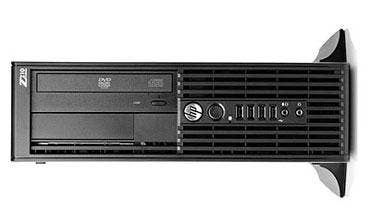HP's Z210 Workstation: Small Form Factor PC Delivers Big Performance

When I was growing up in suburban Long Island, N.Y., my best friend's older brother -- who seemed to be born with a wrench in his hand -- was fitting an old Ford Pinto with a 289 cubic-inch V-8 engine. By the time he was done, that car could literally do wheelies. But looking at the car with its hood down as it rolled through our quiet neighborhood, you'd never suspect what it could do with the power tucked away under few square feet of sheet metal.
That Pinto came to mind as I tested the 15 x 13.5 x 4-inch Z210 Small Form Factor Workstation that Hewlett Packard sent the CRN Test Center this week for review. Expecting small performance from a small box, what we found was something else entirely.
The first thing to impress us was the Z210's boot time. Out of the box, the machine went from powered-off to ready-to-launch-apps in just 26 seconds. Chalk that up, in part, to a 160-GB Intel solid state drive, which is standard equipment in the high-end model that we tested. Also helping to keep boot time short is an unusually short power-on self test (POST) delay. So short, in fact, that HP has published a support advisory with instructions for increasing the POST delay duration. Apparently there were enough complaints from service technicians whose reflexes were slower than those of the cat-like Z210.
Even more impressive were the Z210's Geekbench scores. With Windows set for maximum performance, testers fired up the 64-bit version of Geekbench 2.1.13 and recorded the fastest score from five test runs of 10006. That's faster than many servers we've tested, and 23 percent faster than the 7695 score of an HP Z200 Workstation tested in April 2010. We attribute much of that performance increase to the processor speed bump; last year's quad-core Xeon was running at 2.28 GHz; this year's is at 3.3 GHz.
Next: What You Get Now to the sticker price. The Z210's starting list is $569, which buys an Intel 3.1GHz Core i3 dual-core processor with Intel HD 2000 graphics, 1 -GB of DDR3 memory, a 250-GB 7200 RPM SATA hard drive and an installer kit for Red Hat Enterprise Linux. At the high end is the machine we tested. It was equipped with a Xeon E3-1245 3.3GHz quad-core processor with 8 GB of DDR3 ECC memory and a 160 GB solid state drive and 64-bit Windows 7 Professional pre-installed. Maximum memory is 16 GB.
This machine would carry a list price of $1,799 and deliver on-processor Intel HD P3000 on-processor graphics. The tested machine also was equipped with an optional, discrete video adapter: an NVidia Quadro FX600, which adds $179 to the list price. The side panel is removed with the flip of a lever, and exposes the unit's four memory slots, and single x16 PCIe, x1PCIe and legacy PCI slots. A system diagram adorns the inside surface of the hood; classic HP.
Expansion cards are held in place by a hinged bracket that locks into place when flipped down. Another lever allows the drive-bay assembly to swing out to expose one 5.25-inch external bay and a 3.5-inch bay for a second internal hard drive or outward-facing device such as a tape drive or card reader.
The standard configuration delivers 14 USB 2.0 ports: four on the front, six on the back and the rest internal. The tested machine also included two USB 3.0 ports, implemented on a 1x PCIe card. Also notable is a DisplayPort, two PS/2 ports and a Gigabit Ethernet ports. The front panel also is home to a headphone jack, a headphone/microphone combo jack, power (soft) switch and hard drive access LED.
Power consumption peaked at 98 watts during benchmarks, and settled to about 26 watts during nominal operations. With a three-year, on-site warranty on parts and labor standard, resellers can offer HP Z210-series workstations with confidence, and with the comfort of knowing they are recommended by the CRN Test Center.